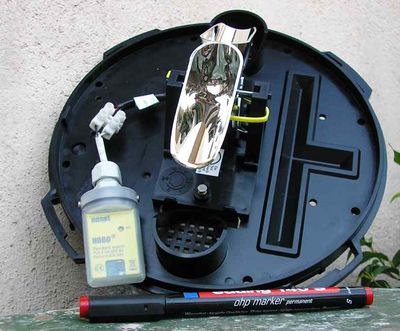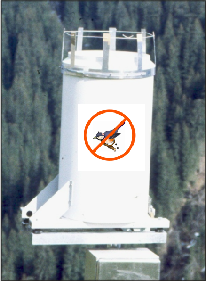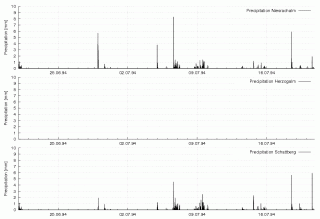The "Things that went wrong"-Story of the Month
Everybody working in the field sometimes has this feeling that things are going wrong more often than not, that both the equipment and nature are conspiring to keep you from getting results. However, these "things that went wrong" are rarely published, despite the fact that there might be a lot to learn from these stories.
So, this is the place to share "things that went wrong"!
If you have a story to tell (with hindsight they are sometimes even funny!), just start writing down below.
The "Things that went wrong"-Story of the Month July
Keep optical interfaces well away from sunlight
The equipment used
We use the HOBO Pendant Event/Temp Data Logger (Part # UA-003-64) for recording the pulses from a DAVIS tipping bucket rain collector (Fig. 1). The logger’s manual can be found at [1].
In order to read out data, the logged has to be plugged into a coupler that is connected to an USB port. We use the HOBO Pendant Coupler, Part # Coupler-UA (Fig. 2). Inside the black plastic box, the logger (left) and the base station (right) communicate via an optical interface.
The problem
Nine such rain gages are currently installed and logger configuration or read-out was not a problem until that sunny day last week. When I connected the coupler to a logger in order to read out the data, the software (HOBOware Pro, Version 2.2.1) confronted me with the following error message (Fig. 3).
After inspecting the information in the help menu, I decided to rewrite the header in order to continue logging somehow. Of course, not only the header data are restored but all data that were previously logged get lost (Fig. 4)!
After loosing the data from a second rain gage (same problem), I decided not to risk more loss of data. Let’s find the cause of the problem. After a while, I realized that the communication is sensitive to the position of the cable running from the USB port to the coupler. When moving the cable, the status (shown in the software’s status bar) switched from 'No device selected...' to the device number (indicating successful connection) and vice versa. I suspected a broken wire in the cable. It also seemed plausible to me that the logger header may become corrupted by too frequent 'Connect & Disconnect' caused by a loose contact (every attachment of the coupler is recorded in the logger’s header).
Back at home, I decided to thoroughly test the cable with an unused logger and to repair the loose contact. However, I was unable to reproduce the problem! However I twisted the cable, the (successful) connection to the logger was not affected at all! Also, frequent connection and disconnection of the cable as well as shutdown, reboot, and stand-by of the used notebook didn’t cause any problems. What to do?
I became unsure whether more (or all) rain gage loggers had been corrupted by the bad coupler cable. So I visited the rain gages four days later. Again, it was bright sunshine and almost 30°C. In order not to risk more data corruption, I carried an alternative coupler cable with me and I decided to test the communication on a free logger before connecting it to the actual rain gage’s logger. What happened?
Using the alternative cable, I got the same communication errors! And, of course, I lost the data from one more rain gage when the logger header became corrupted! I began to think about the differences between my home and the conditions out here. Temperature? Humidity? Magnetic/electric fields? Sunshine? Or is there just not enough power on the USB port when the laptop is running in battery mode?
I began reading the logger’s manual again. The recommended temperature range was 0-50°C. Although the sun was burning, it wasn’t that hot. Then, I remembered that the base station uses optical signals to communicate with the logger. Should the bright sun cause problems? I tightly covered the sun-exposed ends of the logger and the base station (see Fig. 2) with my hands. Suddenly the communication seemed to work. As I removed my hands, the connection broke down. I tried this several times. That’s it!
Lesson learned
- Non-transparent tape should be wrapped around the ends of the logger and the base station which are exposed to daylight. This must be done BEFORE the two parts are plugged into the coupler’s black plastic box. OTHERWISE ONE RISKS CORRUPTING THE LOGGER HEADER AND LOSS OF DATA.
- A device that communicates via an optical interface should probably NOT be made of TRANSPARENT plastic!
The "Things that went wrong"-Story of the Month March
Birds and Raingauges
What we thought:
Let's set up raingauges in our experimental basin where we need them for hydrological reasons.
What really happened (1):
The birds of fields and meadows misunderstood our raingauges for toilet bowls, and their excrements blocked the intake of the tipping buckets resulting in loss of data.
What really happened (2):
The plot above is showing a period of corrupted data. Both stations in the neighbourhood (less than 2 km away) recorded some precipitation events. The one in between just collected water in the inflow funnel and spit it over the observer when he was opening the cover.
Lessons learned:
1. Birds do not sit on very thin cords, and during sitting they hate to be bending down. So we stretched a thin cord a few centimetres above the edge of the raingauge.
2. Always have a look into the pot before opening the cover :-)
This story was brought to you by: Engineering Hydrology & Water Resources Management





